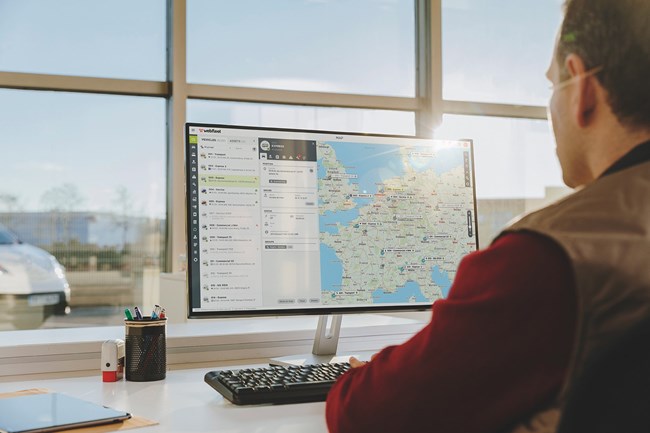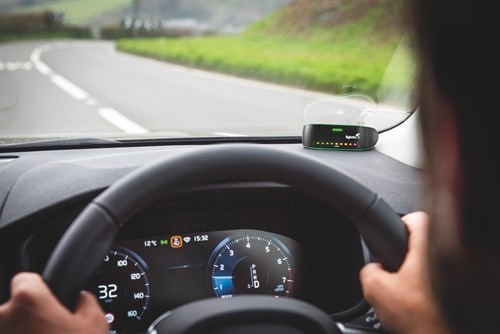- ETRUX launches new Ford E-Transit Trizone
- Renault gives UK debut to Master E-Tech at CV Show
- Isuzu D-Max long-term test – Latest Report
- Isuzu D-Max V-Cross Steel Edition revealed
- IVOTY Report: Stellantis explores the hydrogen proposition
- New Maxus EVs include eDeliver 5 van
- Used LCV values reach six-month high
- ADVERTISEMENT FEATURE: IVECO Daily Mission Awards 2024 Q2 Round-up: Grounds Maintenance & Forestry
- Stellantis Pro One electric vans review
- Mitie adds 5,000th EV to fleet
What Van? Awards 2024: Green Telematics Award – Bridgestone Mobility Solutions
Date: Friday, December 22, 2023

If fleets are to meet the significant challenges association with electric van adoption, it’s important for them to have the right information at their fingertips. This is a need that Bridgestone Mobility Solutions is aiming to meet with the range of eLCV features included with its Webfleet platform.
Its most recent innovation is an EV route optimisation feature that helps businesses to plan routes for drivers taking into account battery levels, capacity, average energy consumption and charger locations. The supply of data on battery levels at the start and end of each trip allows fleets to assess battery capacity alongside energy usage and clearly identify when charging sessions took place.
Webfleet allows managers to track energy usage for every trip made via a data report and also visually. An energy efficiency code for journeys is displayed on a map trace, graded from red to green and offering an immediate picture of the amount of energy used. Webfleet OptiDrive driving behaviour data for coasting and constant speed can be monitored and analysed alongside these insights to improve driver performance.
Webfleet’s reports also include a breakdown of energy used for driving and other purposes, such as the powering of auxiliary equipment or for air conditioning. Additionally, the system details energy recovered through regenerative braking and coasting. This data, according to Bridgestone Mobility Solutions, can play a vital role in measuring and improve driving performance – and, therefore, energy efficiency.
Information on real-time battery levels and remaining driving ranges help with workflow planning, while EV health data enables pre-emptive maintenance.
Webfleet data can also be used to provide guidance for fleets right at the start of their electrification journey. The fleet electrification planning report feature draws on real-world mileages and criteria ranging from road types to standstill times to help fleets identify which of their combustion-engined vehicles could be cost-effectively replaced with EV alternatives.
Webfleet also offers the charger connection insight report, designed to help ensure charging occurs at times of day when tariffs are most favourable and just before vehicles are needed for operation. The feature has also been designed to ensure charge levels are kept within the 20–80% range, the said optimal for minimising battery degradation.
Bridgestone Mobility Solutions says customers using Webfleet to help electrify their fleet include Wren Kitchens. The company is said to be harnessing it to forecast TCO savings by simplifying comparisons between ICE vehicle running costs and real-world EV performance. It is also said to be helping the company to plan for its charging infrastructure needs by confirming where its vehicles spend most time, as well as their typical mileage and dwell times.
Another Webfleet customer, Riverford, is said to be using the system to overcome range anxiety, better manage routes and navigate more efficiently to chargers.
For a third customer, Mitchells of Mansfield, it is said to be underpinning a commitment to
become carbon neutral by 2027. Rather than investing in an expensive proprietary charger, the company has run a three-phase electrical cable out to a charging post, with Webfleet issuing alerts when an EV is plugged in, when it has reached capacity and if there are any interruptions.
Highly Commended: Lightfoot

Lightfoot believes the key to unlocking sustainable driving is changing driver behaviour, and its in-cab driver coaching system is designed to achieve this through positive reinforcement.
As well as giving real-time feedback to help drivers improve in the moment, it gives them access to a rewards app that provides incentivisation in the form of prizes, high score tables and recognition.
Lightfoot says its system is proven to reduce CO2 emissions by an average of 15% in petrol and diesel vehicles, while with EVs, a 15% average improvement in range is produced.
For ICE vehicles, research from the University of Bath’s Institute of Advanced Automotive Propulsion Systems found that Lightfoot’s driver coaching technology leads to a fivefold reduction in NOx – one of the leading causes of air pollution – because of reductions in aggressive driving, with less strain on the engine resulting in fewer emissions being produced.
Lightfoot’s technology is also said to prevent 45% of vehicle wear and tear, reducing harmful particulate emissions from components such as brakes and tyres.
View The WhatVan Digital Edition


